
Bird anatomy
Encyclopedia
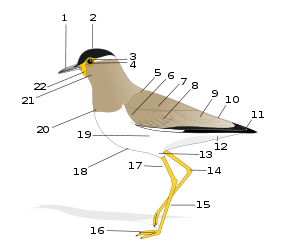
Physiology
Physiology is the science of the function of living systems. This includes how organisms, organ systems, organs, cells, and bio-molecules carry out the chemical or physical functions that exist in a living system. The highest honor awarded in physiology is the Nobel Prize in Physiology or...
of bird
Bird
Birds are feathered, winged, bipedal, endothermic , egg-laying, vertebrate animals. Around 10,000 living species and 188 families makes them the most speciose class of tetrapod vertebrates. They inhabit ecosystems across the globe, from the Arctic to the Antarctic. Extant birds range in size from...
s' bodies, shows many unique adaptations, mostly aiding flight
Bird flight
Flight is the main mode of locomotion used by most of the world's bird species. Flight assists birds while feeding, breeding and avoiding predators....
. Birds have a light skeletal system and light but powerful musculature which, along with circulatory and respiratory systems capable of very high metabolic rates and oxygen
Oxygen
Oxygen is the element with atomic number 8 and represented by the symbol O. Its name derives from the Greek roots ὀξύς and -γενής , because at the time of naming, it was mistakenly thought that all acids required oxygen in their composition...
supply, permit the bird to fly. The development of a beak
Beak
The beak, bill or rostrum is an external anatomical structure of birds which is used for eating and for grooming, manipulating objects, killing prey, fighting, probing for food, courtship and feeding young...
has led to evolution
Evolution
Evolution is any change across successive generations in the heritable characteristics of biological populations. Evolutionary processes give rise to diversity at every level of biological organisation, including species, individual organisms and molecules such as DNA and proteins.Life on Earth...
of a specially adapted digestive system. These anatomical
Anatomy
Anatomy is a branch of biology and medicine that is the consideration of the structure of living things. It is a general term that includes human anatomy, animal anatomy , and plant anatomy...
specializations have earned birds their own class in the vertebrate
Vertebrate
Vertebrates are animals that are members of the subphylum Vertebrata . Vertebrates are the largest group of chordates, with currently about 58,000 species described. Vertebrates include the jawless fishes, bony fishes, sharks and rays, amphibians, reptiles, mammals, and birds...
phylum
Phylum
In biology, a phylum The term was coined by Georges Cuvier from Greek φῦλον phylon, "race, stock," related to φυλή phyle, "tribe, clan." is a taxonomic rank below kingdom and above class. "Phylum" is equivalent to the botanical term division....
.
Respiratory system
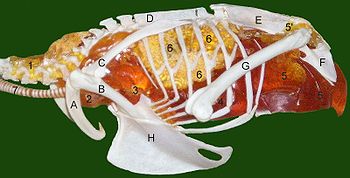
These sacs do not play a direct role in gas exchange, but to store air and act like bellows
Bellows
A bellows is a device for delivering pressurized air in a controlled quantity to a controlled location.Basically, a bellows is a deformable container which has an outlet nozzle. When the volume of the bellows is decreased, the air escapes through the outlet...
, allowing the lungs to maintain a fixed volume with fresh air constantly flowing through them.
Three distinct sets of organs perform respiration
Respiration (physiology)
'In physiology, respiration is defined as the transport of oxygen from the outside air to the cells within tissues, and the transport of carbon dioxide in the opposite direction...
—the anterior
Anatomical terms of location
Standard anatomical terms of location are designations employed in science that deal with the anatomy of animals to avoid ambiguities that might otherwise arise. They are not language-specific, and thus require no translation...
air sacs (interclavicular
Clavicle
In human anatomy, the clavicle or collar bone is a long bone of short length that serves as a strut between the scapula and the sternum. It is the only long bone in body that lies horizontally...
, cervicals
Neck
The neck is the part of the body, on many terrestrial or secondarily aquatic vertebrates, that distinguishes the head from the torso or trunk. The adjective signifying "of the neck" is cervical .-Boner anatomy: The cervical spine:The cervical portion of the human spine comprises seven boney...
, and anterior thoracics), the lungs, and the posterior
Anatomical terms of location
Standard anatomical terms of location are designations employed in science that deal with the anatomy of animals to avoid ambiguities that might otherwise arise. They are not language-specific, and thus require no translation...
air sacs (posterior thoracics and abdominals). The posterior and anterior air sacs, typically nine, expand during inhalation. Air enters the bird via the trachea. Half of the inhaled air enters the posterior air sacs, the other half passes through the lungs and into the anterior air sacs. Air from the anterior air sacs empties directly into the trachea and out the bird's mouth or nares. The posterior air sacs empty their air into the lungs. Air passing through the lungs as the bird exhales is expelled via the trachea
Vertebrate trachea
In tetrapod anatomy the trachea, or windpipe, is a tube that connects the pharynx or larynx to the lungs, allowing the passage of air. It is lined with pseudostratified ciliated columnar epithelium cells with goblet cells that produce mucus...
. Some taxonomic groups (Passeriformes) possess 7 air sacs, as the clavicular air sacs may interconnect or be fused with the cranial thoracic air sacs.
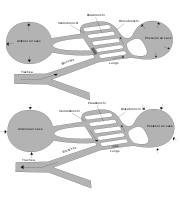
Carbon dioxide
Carbon dioxide is a naturally occurring chemical compound composed of two oxygen atoms covalently bonded to a single carbon atom...
-rich, air as in mammalian lungs. Thus, the partial pressure
Partial pressure
In a mixture of ideal gases, each gas has a partial pressure which is the pressure which the gas would have if it alone occupied the volume. The total pressure of a gas mixture is the sum of the partial pressures of each individual gas in the mixture....
of oxygen in a bird's lungs is the same as the environment, and so birds have more efficient gas-exchange of both oxygen and carbon dioxide than do mammals. In addition, air passes through the lungs in both exhalation and inspiration, with the air sacs functioning as a reservoir for the next breath of air.
Avian lungs do not have alveoli, as mammalian lungs do, but instead contain millions of tiny passages known as parabronchi, connected at either ends by the dorsobronchi and ventrobronchi. Air flows through the honeycombed walls of the parabronchi into air vesicles, called atria, which project radially from the parabronchi. These atria give rise to air capillaries
Capillary
Capillaries are the smallest of a body's blood vessels and are parts of the microcirculation. They are only 1 cell thick. These microvessels, measuring 5-10 μm in diameter, connect arterioles and venules, and enable the exchange of water, oxygen, carbon dioxide, and many other nutrient and waste...
, where oxygen and carbon dioxide are traded with cross-flowing blood capillaries by diffusion.
Birds also lack a diaphragm
Thoracic diaphragm
In the anatomy of mammals, the thoracic diaphragm, or simply the diaphragm , is a sheet of internal skeletal muscle that extends across the bottom of the rib cage. The diaphragm separates the thoracic cavity from the abdominal cavity and performs an important function in respiration...
. The entire body cavity acts as a bellows to move air through the lungs. The active phase of respiration in birds is exhalation, requiring muscular contraction.
The syrinx
Syrinx (biology)
Syrinx is the name for the vocal organ of birds. Located at the base of a bird's trachea, it produces sounds without the vocal cords of mammals. The sound is produced by vibrations of some or all of the membrana tympaniformis and the pessulus caused by air flowing through the syrinx...
is the sound-producing vocal organ of birds, located at the base of a bird's trachea. As with the mammalian larynx
Larynx
The larynx , commonly called the voice box, is an organ in the neck of amphibians, reptiles and mammals involved in breathing, sound production, and protecting the trachea against food aspiration. It manipulates pitch and volume...
, sound is produced by the vibration of air flowing through the organ. The syrinx enables some species of birds to produce extremely complex vocalizations, even mimicking human speech. In some songbirds, the syrinx can produce more than one sound at a time.
Circulatory system
Birds have a four-chambered heartHeart
The heart is a myogenic muscular organ found in all animals with a circulatory system , that is responsible for pumping blood throughout the blood vessels by repeated, rhythmic contractions...
, in common with humans, most mammals, and some other reptiles (namely the crocodilia
Crocodilia
Crocodilia is an order of large reptiles that appeared about 84 million years ago in the late Cretaceous Period . They are the closest living relatives of birds, as the two groups are the only known survivors of the Archosauria...
). This adaptation allows for an efficient nutrient and oxygen transport throughout the body, providing birds with energy to fly and maintain high levels of activity. A Ruby-throated Hummingbird
Ruby-throated Hummingbird
The Ruby-throated Hummingbird , is a small hummingbird. It is the only species of hummingbird that regularly nests east of the Mississippi River in North America.- Description :...
's heart beats up to 1200 times per minute (about 20 beats per second).
Digestive system
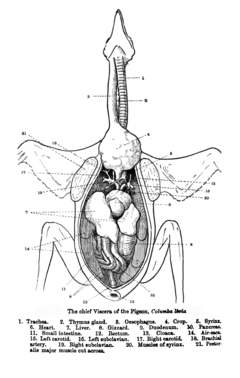
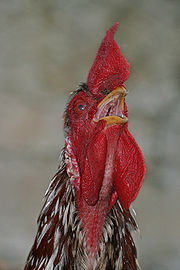
Crop (anatomy)
A crop is a thin-walled expanded portion of the alimentary tract used for the storage of food prior to digestion that is found in many animals, including gastropods, earthworms, leeches, insects, birds, and even some dinosaurs.- Bees :Cropping is used by bees to temporarily store nectar of flowers...
. The crop functions to both soften food and regulate its flow through the system by storing it temporarily. The size and shape of the crop is quite variable among the birds. Members of the order Columbiformes
Columbiformes
Columbiformes are an avian order that includes the very widespread and successful doves and pigeons, classified in the family Columbidae, and the extinct Dodo and the Rodrigues Solitaire, long classified as a second family Raphidae. 313 species, found worldwide, comprise the Columbiformes order....
, such as pigeons, produce a nutritious crop milk
Crop milk
Crop milk is a secretion from the lining of the crop of parent birds that is regurgitated to young birds. They are found among all pigeons and doves where they are referred to as pigeon milk...
which is fed to their young by regurgitation. Birds possess a ventriculus, or gizzard
Gizzard
The gizzard, also referred to as the ventriculus, gastric mill, and gigerium, is an organ found in the digestive tract of some animals, including birds, reptiles, earthworms and some fish. This specialized stomach constructed of thick, muscular walls is used for grinding up food; often rocks are...
, composed of four muscular bands that rotate and crush food by shifting the food from one area to the next within the gizzard. The gizzard of some species contains small pieces of grit or stone swallowed by the bird to aid in the grinding process of digestion
Digestion
Digestion is the mechanical and chemical breakdown of food into smaller components that are more easily absorbed into a blood stream, for instance. Digestion is a form of catabolism: a breakdown of large food molecules to smaller ones....
, serving the function of mammalian or reptilian teeth. The use of gizzard stones is a similarity between birds and dinosaurs, which left gizzard stones called gastrolith
Gastrolith
A gastrolith, also called a stomach stone or gizzard stones, is a rock held inside a gastrointestinal tract. Gastroliths are retained in the muscular gizzard and used to grind food in animals lacking suitable grinding teeth. The grain size depends upon the size of the animal and the gastrolith's...
s as trace fossil
Trace fossil
Trace fossils, also called ichnofossils , are geological records of biological activity. Trace fossils may be impressions made on the substrate by an organism: for example, burrows, borings , urolites , footprints and feeding marks, and root cavities...
s.
Drinking behavior
There are four general ways in which birds drink.Most birds are unable to swallow by the "sucking" or "pumping" action of peristalsis
Peristalsis
Peristalsis is a radially symmetrical contraction and relaxation of muscles which propagates in a wave down the muscular tube, in an anterograde fashion. In humans, peristalsis is found in the contraction of smooth muscles to propel contents through the digestive tract. Earthworms use a similar...
in their esophagus
Esophagus
The esophagus is an organ in vertebrates which consists of a muscular tube through which food passes from the pharynx to the stomach. During swallowing, food passes from the mouth through the pharynx into the esophagus and travels via peristalsis to the stomach...
(as humans do), and drink by repeatedly raising their heads after filling their mouths to allow the liquid to flow by gravity, a method usually described as "sipping" or "tipping up".
The notable exception is the Columbiformes
Columbiformes
Columbiformes are an avian order that includes the very widespread and successful doves and pigeons, classified in the family Columbidae, and the extinct Dodo and the Rodrigues Solitaire, long classified as a second family Raphidae. 313 species, found worldwide, comprise the Columbiformes order....
; in fact, according to Konrad Lorenz
Konrad Lorenz
Konrad Zacharias Lorenz was an Austrian zoologist, ethologist, and ornithologist. He shared the 1973 Nobel Prize with Nikolaas Tinbergen and Karl von Frisch...
in 1939,
- "one recognizes the order by the single behavioral characteristic, namely that in drinking the water is pumped up by peristalsis of the esophagus which occurs without exception within the order. The only other group, however, which shows the same behavior, the Pteroclidae, is placed near the doves just by this doubtlessly very old characteristic."
Although this general rule still stands, since that time, observations have been made of a few exceptions in both directions.,
In addition, specialized nectar feeders like sunbirds (Nectariniidae) and hummingbirds (Trochilidae) drink
by using protrusible grooved or trough-like tongues, and parrots (Psittacidae) lap up water.
Many seabirds have glands near the eyes that allow them to drink seawater. Excess salt is eliminated from the nostrils. Many desert birds get the water that they need entirely from their food. The elimination of nitrogenous wastes as uric acid
Uricotelic
An Uricotelic organism produces uric acid as a result of deamination. An example of such an organisms include birds and insects. Other methods of deamination include Ammoniotelic and Ureotelic....
reduces the physiological demand for water.
Skeletal system
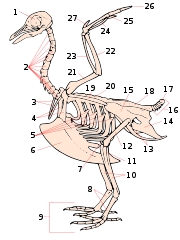
Adaptation
An adaptation in biology is a trait with a current functional role in the life history of an organism that is maintained and evolved by means of natural selection. An adaptation refers to both the current state of being adapted and to the dynamic evolutionary process that leads to the adaptation....
for flight
Flight
Flight is the process by which an object moves either through an atmosphere or beyond it by generating lift or propulsive thrust, or aerostatically using buoyancy, or by simple ballistic movement....
. It is extremely lightweight but strong enough to withstand the stresses
Stress (physics)
In continuum mechanics, stress is a measure of the internal forces acting within a deformable body. Quantitatively, it is a measure of the average force per unit area of a surface within the body on which internal forces act. These internal forces are a reaction to external forces applied on the body...
of taking off, flying, and landing. One key adaptation is the fusing of bone
Bone
Bones are rigid organs that constitute part of the endoskeleton of vertebrates. They support, and protect the various organs of the body, produce red and white blood cells and store minerals. Bone tissue is a type of dense connective tissue...
s into single ossification
Ossification
Ossification is the process of laying down new bone material by cells called osteoblasts. It is synonymous with bone tissue formation...
s, such as the pygostyle
Pygostyle
Pygostyle refers to a number of the final few caudal vertebrae fused into a single ossification, supporting the tail feathers and musculature. In modern birds, the rectrices attach to these....
. Because of this, birds usually have a smaller number of bones than other terrestrial vertebrates. Birds also lack teeth or even a true jaw
Jaw
The jaw is any opposable articulated structure at the entrance of the mouth, typically used for grasping and manipulating food. The term jaws is also broadly applied to the whole of the structures constituting the vault of the mouth and serving to open and close it and is part of the body plan of...
, instead having evolved a beak
Beak
The beak, bill or rostrum is an external anatomical structure of birds which is used for eating and for grooming, manipulating objects, killing prey, fighting, probing for food, courtship and feeding young...
, which is far more lightweight. The beaks of many baby birds have a projection called an egg tooth
Egg tooth
In some egg-laying animals, the egg tooth is a small, sharp, cranial protuberance used by offspring to break or tear through the egg's surface during hatching...
, which facilitates their exit from the amniotic egg.
Birds have many bones that are hollow (pneumatized
Skeletal pneumaticity
Skeletal pneumaticity is the presence of air spaces within bones. Skeletal pneumaticity exists only in synapsids and archosaurs. It is generally produced during development by excavation of bone by pneumatic diverticula from an air-filled space such as the lungs or nasal cavity...
) with criss-crossing strut
Strut
A strut is a structural component designed to resist longitudinal compression. Struts provide outwards-facing support in their lengthwise direction, which can be used to keep two other components separate, performing the opposite function of a tie...
s or truss
Truss
In architecture and structural engineering, a truss is a structure comprising one or more triangular units constructed with straight members whose ends are connected at joints referred to as nodes. External forces and reactions to those forces are considered to act only at the nodes and result in...
es for structural strength
Strength of materials
In materials science, the strength of a material is its ability to withstand an applied stress without failure. The applied stress may be tensile, compressive, or shear. Strength of materials is a subject which deals with loads, deformations and the forces acting on a material. A load applied to a...
. The number of hollow bones varies among species, though large gliding and soaring birds tend to have the most. Respiratory air sacs often form air pockets within the semi-hollow bones of the bird's skeleton. Some flightless birds like penguins and ostriches have only solid bones, further evidencing the link between flight and the adaptation of hollow bones.
Birds also have more cervical (neck) vertebrae than many other animals; most have a highly flexible neck consisting of 13-25 vertebrae. Birds are the only vertebrate
Vertebrate
Vertebrates are animals that are members of the subphylum Vertebrata . Vertebrates are the largest group of chordates, with currently about 58,000 species described. Vertebrates include the jawless fishes, bony fishes, sharks and rays, amphibians, reptiles, mammals, and birds...
animals to have a fused collarbone (the furcula
Furcula
The ' is a forked bone found in birds, formed by the fusion of the two clavicles. In birds, its function is the strengthening of the thoracic skeleton to withstand the rigors of flight....
or wishbone) or a keeled
Keel (bird)
A keel or carina in bird anatomy is an extension of the sternum which runs axially along the midline of the sternum and extends outward, perpendicular to the plane of the ribs. The keel provides an anchor to which a bird's wing muscles attach, thereby providing adequate leverage for flight...
sternum
Sternum
The sternum or breastbone is a long flat bony plate shaped like a capital "T" located anteriorly to the heart in the center of the thorax...
or breastbone. The keel of the sternum serves as an attachment site for the muscles used for flight, or similarly for swimming in penguins. Again, flightless birds, such as ostriches, which do not have highly developed pectoral muscles
Pectoral muscles
Pectoral muscles can refer to:* Pectoralis major muscle* Pectoralis minor muscle...
, lack a pronounced keel on the sternum. It is noted that swimming birds have a wide sternum, while walking birds had a long or high sternum while flying birds have the width and height nearly equal.
Birds have uncinate processes
Uncinate processes of ribs
The uncinate processes of the ribs are extensions of bone that in birds project caudally from the vertical segment of each rib. These processes help to strengthen the rib cage of birds by overlapping with the rib behind them...
on the ribs. These are hooked extensions of bone which help to strengthen the rib cage by overlapping with the rib behind them. This feature is also found in the tuatara Sphenodon. They also have a greatly elongate tetradiate pelvis
Pelvis
In human anatomy, the pelvis is the lower part of the trunk, between the abdomen and the lower limbs .The pelvis includes several structures:...
as in some reptiles. The hindlimb has an intra-tarsal joint found also in some reptiles. There is extensive fusion of the trunk vertebrae as well as fusion with the pectoral girdle. They have a diapsid skull as in reptiles with a pre-lachrymal fossa (present in some reptiles). The skull has a single occipital condyle.
Skeleton
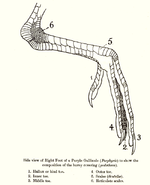
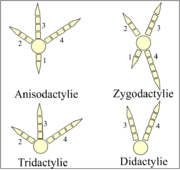
The vertebral column consists of vertebrae, and is divided into three sections: cervical (11-25) (neck), Synsacrum
Synsacrum
The synsacrum is a skeletal structure, mainly described in birds and dinosaurs, in which the sacrum is extended by incorporation of additional fused or partially-fused caudal or lumbar vertebrae. The ilium of the pelvis is attached to the synsacrum and, in some species, may also be fused to it...
(fused vertebrae of the back, also fused to the hips (pelvis)), and pygostyle (tail).
The chest consists of the furcula (wishbone) and coracoid (collar bone), which two bones, together with the scapula (see below), form the pectoral girdle. The side of the chest is formed by the ribs, which meet at the sternum (mid-line of the chest).
The shoulder consists of the scapula (shoulder blade), coracoid (see The Chest), and humerus (upper arm). The humerus joins the radius and ulna (forearm) to form the elbow. The carpus and metacarpus form the "wrist" and "hand" of the bird, and the digits (fingers) are fused together. The bones in the wing are extremely light so that the bird can fly more easily.
The hips consist of the pelvis which includes three major bones: Illium (top of the hip), Ischium (sides of hip), and Pubis (front of the hip). These are fused into one (the innominate bone). Innominate bones are evolutionary significant in that they allow birds to lay eggs. They meet at the acetabulum (the hip socket) and articulate with the femur, which is the first bone of the hind limb.
The upper leg consists of the femur. At the knee joint, the femur connects to the tibiotarsus
Tibiotarsus
The tibiotarsus is the large bone between the femur and the tarsometatarsus in the leg of a bird. It is the fusion of the proximal part of the tarsus with the tibia.A similar structure also occurred in the Mesozoic Heterodontosauridae...
(shin) and fibula (side of lower leg). The tarsometatarsus forms the upper part of the foot, digits make up the toes. The leg bones of birds are the heaviest, contributing to a low center of gravity. This aids in flight. A bird's skeleton comprises only about 5% of its total body weight
Birds feet
Dactyly
In biology, dactyly is the arrangement of digits on the hands, feet, or sometimes wings of a tetrapod animal. It comes from the Greek word δακτυλος = "finger".Sometimes the ending "-dactylia" is used...
are classificated as anisodactyl, zygodactyl, heterodactyl, syndactyl or pamprodactyl.
Muscular system

Pectoral muscles
Pectoral muscles can refer to:* Pectoralis major muscle* Pectoralis minor muscle...
, or the breast muscles, which control the wings and make up about 15 - 25% of a flighted bird’s body weight. They provide the powerful wing stroke essential for flight. The muscle medial
Medial
- Medial magmas :In abstract algebra, a medial magma is a set with a binary operation which satisfies the identity \cdot = \cdot , or more simply, xy\cdot uv = xu\cdot yv...
(underneath) to the pectorals is the supracoracoideus. It raises the wing between wingbeats. The supracoracoideus and the pectorals together make up about 25 – 35% of the bird's full body weight.
The skin muscles help a bird in its flight by adjusting the feathers, which are attached to the skin muscle and help the bird in its flight maneuvers.
There are only a few muscles in the trunk and the tail, but they are very strong and are essential for the bird. The pygostyle controls all the movement in the tail and controls the feathers in the tail. This gives the tail a larger surface area which helps keep the bird in the air.
Head
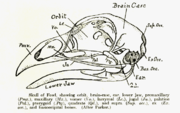
Bird of prey
Birds of prey are birds that hunt for food primarily on the wing, using their keen senses, especially vision. They are defined as birds that primarily hunt vertebrates, including other birds. Their talons and beaks tend to be relatively large, powerful and adapted for tearing and/or piercing flesh....
s have vision eight times sharper than humans - thanks to higher densities of photoreceptors in the retina (up to 1,000,000 per square mm in Buteo
Buteo
Buteo is a genus of medium to fairly large, wide-ranging raptors with a robust body and broad wings. In the Old World, members of this genus are called "buzzards", but "hawk" is used in North America...
s, compared to 200,000 for humans), a high number of optic nerve
Optic nerve
The optic nerve, also called cranial nerve 2, transmits visual information from the retina to the brain. Derived from the embryonic retinal ganglion cell, a diverticulum located in the diencephalon, the optic nerve doesn't regenerate after transection.-Anatomy:The optic nerve is the second of...
s, a second set of eye muscles not found in other animals, and, in some cases, an indented fovea
Fovea
The fovea centralis, also generally known as the fovea , is a part of the eye, located in the center of the macula region of the retina....
which magnifies the central part of the visual field. Many species, including hummingbird
Hummingbird
Hummingbirds are birds that comprise the family Trochilidae. They are among the smallest of birds, most species measuring in the 7.5–13 cm range. Indeed, the smallest extant bird species is a hummingbird, the 5-cm Bee Hummingbird. They can hover in mid-air by rapidly flapping their wings...
s and albatross
Albatross
Albatrosses, of the biological family Diomedeidae, are large seabirds allied to the procellariids, storm-petrels and diving-petrels in the order Procellariiformes . They range widely in the Southern Ocean and the North Pacific...
es, have two foveas in each eye. Many birds can detect polarised light. The eye occupies a considerable part of the skull and is surrounded by a sclerotic eye-ring, a ring of tiny bones that surround the eye. This character is also seen in the reptiles.
The bills of many waders have Herbst corpuscles which help them detect prey hidden under wet sand using minute pressure differences in the water. All extant birds can move the parts of the upper jaw relative to the brain case. However this is more prominent in some birds and can be readily detected in parrots.
Birds have a large brain to body mass ratio. This is reflected in the advanced and complex bird intelligence
Bird intelligence
Bird intelligence deals with the definition of intelligence and its measurement as it applies to birds. Traditionally, birds have been considered inferior in intelligence to mammals, and derogatory terms such as bird brains have been used colloquially in some cultures. Such perceptions are no...
.
The region between the eye and bill on the side of a bird's head is called the lore
Lore (anatomy)
The Lore is the region between the eye and bill on the side of a bird's head. This region is sometimes featherless, and the skin may be tinted, as in many species of the cormorant family. This area, which is directly in front of the eye, features a "loral stripe" in many bird species including the...
. This region is sometimes featherless, and the skin may be tinted, as in many species of the cormorant
Cormorant
The bird family Phalacrocoracidae is represented by some 40 species of cormorants and shags. Several different classifications of the family have been proposed recently, and the number of genera is disputed.- Names :...
family.
Reproduction

Testicle
The testicle is the male gonad in animals. Like the ovaries to which they are homologous, testes are components of both the reproductive system and the endocrine system...
which become hundreds of times larger during the breeding season to produce sperm
Spermatozoon
A spermatozoon is a motile sperm cell, or moving form of the haploid cell that is the male gamete. A spermatozoon joins an ovum to form a zygote...
. The testes in male birds are generally asymmetric with most birds having a larger left testis. Female birds in most families have only one functional ovary
Ovary
The ovary is an ovum-producing reproductive organ, often found in pairs as part of the vertebrate female reproductive system. Ovaries in anatomically female individuals are analogous to testes in anatomically male individuals, in that they are both gonads and endocrine glands.-Human anatomy:Ovaries...
(the left one), connected to an oviduct - although two ovaries are present in the embryonic stage of each female bird. Some species of birds have two functional ovaries, and the order Apterygiformes always retain both ovaries.
In the males of species without a phallus
Phallus
A phallus is an erect penis, a penis-shaped object such as a dildo, or a mimetic image of an erect penis. Any object that symbolically resembles a penis may also be referred to as a phallus; however, such objects are more often referred to as being phallic...
(see below), sperm is stored in the semen
Semen
Semen is an organic fluid, also known as seminal fluid, that may contain spermatozoa. It is secreted by the gonads and other sexual organs of male or hermaphroditic animals and can fertilize female ova...
al glomera within the cloaca
Cloaca
In zoological anatomy, a cloaca is the posterior opening that serves as the only such opening for the intestinal, reproductive, and urinary tracts of certain animal species...
l protuberance prior to copulation. During copulation, the female moves her tail to the side and the male either mounts the female from behind or in front (in the stitchbird
Stitchbird
The Stitchbird or Hihi is a rare honeyeater-like bird endemic to the North Island and adjacent offshore islands of New Zealand. It became extirpated everywhere except Little Barrier Island but has been reintroduced to three other island sanctuaries and two locations on the North Island mainland...
), or moves very close to her. The cloaca
Cloaca
In zoological anatomy, a cloaca is the posterior opening that serves as the only such opening for the intestinal, reproductive, and urinary tracts of certain animal species...
e then touch, so that the sperm can enter the female's reproductive tract. This can happen very fast, sometimes in less than half a second.
The sperm is stored in the female's sperm storage tubule
Tubule
A tubule is a very small tube or fistular structure.A system of surface-connected membranes in muscle that enables a nerve impulse to travel to the interior of the muscle fibre.In anatomy, a tubule is a minute tube lined with glandular epithelium....
s for a week to more than a 100 days, depending on the species. Then, eggs will be fertilized individually as they leave the ovaries, before the shell is calcified (for species that produce hard shells) in the oviduct
Oviduct
In non-mammalian vertebrates, the passageway from the ovaries to the outside of the body is known as the oviduct. The eggs travel along the oviduct. These eggs will either be fertilized by sperm to become a zygote, or will degenerate in the body...
. After the egg is laid by the female, the embryo continues to develop in the egg outside the female body.

Waterfowl
Waterfowl are certain wildfowl of the order Anseriformes, especially members of the family Anatidae, which includes ducks, geese, and swans....
and some other birds, such as the ostrich
Ostrich
The Ostrich is one or two species of large flightless birds native to Africa, the only living member of the genus Struthio. Some analyses indicate that the Somali Ostrich may be better considered a full species apart from the Common Ostrich, but most taxonomists consider it to be a...
and turkey
Turkey (bird)
A turkey is a large bird in the genus Meleagris. One species, Meleagris gallopavo, commonly known as the Wild Turkey, is native to the forests of North America. The domestic turkey is a descendant of this species...
, possess a phallus
Phallus
A phallus is an erect penis, a penis-shaped object such as a dildo, or a mimetic image of an erect penis. Any object that symbolically resembles a penis may also be referred to as a phallus; however, such objects are more often referred to as being phallic...
. The length is thought to be related to sperm competition. When not copulating, it is hidden within the proctodeum
Proctodeum
A proctodeum is the back ectodermal part of an alimentary canal. It is created during embryogenesis by a folding of the outer body wall. It will form the lower part of the anal canal, below the pectinate line, which will be lined by stratified squamous non-keratinized and stratified squamous...
compartment within the cloaca, just inside the vent.
After the eggs hatch, parents provide varying degrees of care in terms of food and protection. Precocial
Precocial
In biology, the term precocial refers to species in which the young are relatively mature and mobile from the moment of birth or hatching. The opposite developmental strategy is called "altricial," where the young are born or hatched helpless. Extremely precocial species may be called...
birds can care for themselves independently within minutes of hatching; altricial
Altricial
Altricial, meaning "requiring nourishment", refers to a pattern of growth and development in organisms which are incapable of moving around on their own soon after hatching or being born...
hatchlings are helpless, blind, and naked, and require extended parental care. The chicks of many ground-nesting birds such as partridge
Partridge
Partridges are birds in the pheasant family, Phasianidae. They are a non-migratory Old World group.These are medium-sized birds, intermediate between the larger pheasants and the smaller quails. Partridges are native to Europe, Asia, Africa, and the Middle East...
s and wader
Wader
Waders, called shorebirds in North America , are members of the order Charadriiformes, excluding the more marine web-footed seabird groups. The latter are the skuas , gulls , terns , skimmers , and auks...
s are often able to run virtually immediately after hatching; such birds are referred to as nidifugous
Nidifugous
Nidifugous organisms are those that leave the nest shortly after hatching or birth. It is derived from Latin nidus for "nest" and fugere meaning "to flee". The terminology is most often used to describe birds and was introduced by Lorenz Oken in 1916...
. The young of hole-nesters, on the other hand, are often totally incapable of unassisted survival. The process whereby a chick acquires feathers until it can fly is called "fledging".
Some birds, such as pigeons, geese, and Red-crowned Crane
Red-crowned Crane
The Red-crowned Crane , also called the Japanese Crane or Manchurian Crane , is a large east Asian crane and among the rarest cranes in the world...
s, remain with their mates for life and may produce offspring on a regular basis.
Scales
The scales of birds are composed of the same keratin as beaks, claws, and spurs. They are found mainly on the toes and metatarsusMetatarsus
The metatarsus or metatarsal bones are a group of five long bones in the foot located between the tarsal bones of the hind- and mid-foot and the phalanges of the toes. Lacking individual names, the metatarsal bones are numbered from the medial side : the first, second, third, fourth, and fifth...
, but may be found further up on the ankle in some birds. Most bird scales do not overlap significantly, except in the cases of kingfisher
Kingfisher
Kingfishers are a group of small to medium sized brightly coloured birds in the order Coraciiformes. They have a cosmopolitan distribution, with most species being found in the Old World and Australia...
s and woodpecker
Woodpecker
Woodpeckers are near passerine birds of the order Piciformes. They are one subfamily in the family Picidae, which also includes the piculets and wrynecks. They are found worldwide and include about 180 species....
s.
The scales and scutes of birds are thought to be homologous
Homology (biology)
Homology forms the basis of organization for comparative biology. In 1843, Richard Owen defined homology as "the same organ in different animals under every variety of form and function". Organs as different as a bat's wing, a seal's flipper, a cat's paw and a human hand have a common underlying...
to those of reptiles and mammals.
Bird embryos begin development with smooth skin. On the feet, the corneum
Stratum corneum
The stratum corneum is the outermost layer of the epidermis, consisting of dead cells that lack nuclei and organelles. The purpose of the stratum corneum is to form a barrier to protect underlying tissue from infection, dehydration, chemicals and mechanical stress...
, or outermost layer, of this skin may keratinize, thicken and form scales. These scales can be organized into;
- Cancella – minute scales which are really just a thickening and hardening of the skin, crisscrossed with shallow grooves.
- Reticula – small but distinct, separate, scales. Found on the lateralAnatomical terms of locationStandard anatomical terms of location are designations employed in science that deal with the anatomy of animals to avoid ambiguities that might otherwise arise. They are not language-specific, and thus require no translation...
and medialMedial- Medial magmas :In abstract algebra, a medial magma is a set with a binary operation which satisfies the identity \cdot = \cdot , or more simply, xy\cdot uv = xu\cdot yv...
surfaces (sides) of the chicken metatarsusMetatarsusThe metatarsus or metatarsal bones are a group of five long bones in the foot located between the tarsal bones of the hind- and mid-foot and the phalanges of the toes. Lacking individual names, the metatarsal bones are numbered from the medial side : the first, second, third, fourth, and fifth...
. These are made up of alpha-keratin. - Scutella – scales that are not quite as large as scutes, such as those found on the caudal, or hind part, of the chicken metatarsusMetatarsusThe metatarsus or metatarsal bones are a group of five long bones in the foot located between the tarsal bones of the hind- and mid-foot and the phalanges of the toes. Lacking individual names, the metatarsal bones are numbered from the medial side : the first, second, third, fourth, and fifth...
. - ScuteScuteA scute or scutum is a bony external plate or scale, as on the shell of a turtle, the skin of crocodilians, the feet of some birds or the anterior portion of the mesonotum in insects.-Properties:...
s – the largest scales, usually on the anterior surface of the metatarsusMetatarsusThe metatarsus or metatarsal bones are a group of five long bones in the foot located between the tarsal bones of the hind- and mid-foot and the phalanges of the toes. Lacking individual names, the metatarsal bones are numbered from the medial side : the first, second, third, fourth, and fifth...
and dorsalDorsum (biology)In anatomy, the dorsum is the upper side of animals that typically run, fly, or swim in a horizontal position, and the back side of animals that walk upright. In vertebrates the dorsum contains the backbone. The term dorsal refers to anatomical structures that are either situated toward or grow...
surface of the toes. These are made up of beta-keratin as in reptilian scales.
The rows of scutes on the anterior of the metatarsus
Metatarsus
The metatarsus or metatarsal bones are a group of five long bones in the foot located between the tarsal bones of the hind- and mid-foot and the phalanges of the toes. Lacking individual names, the metatarsal bones are numbered from the medial side : the first, second, third, fourth, and fifth...
can be called an acrometatarsium or acrotarsium.
Feathers can be intermixed with scales on some birds' feet. Feather follicles can lie between scales or even directly beneath them, in the deeper dermis
Dermis
The dermis is a layer of skin between the epidermis and subcutaneous tissues, and is composed of two layers, the papillary and reticular dermis...
layer of the skin. In this last case, feathers may emerge directly through scales, and be encircled at the plane of emergence entirely by the keratin of the scale.

